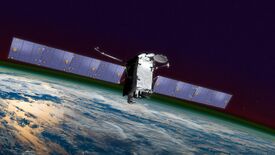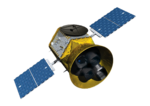Global-scale Observations of the Limb and Disk
Topic: Astronomy
 From HandWiki - Reading time: 4 min
From HandWiki - Reading time: 4 min
 SES-14 with GOLD (bottom left of spacecraft) | |
| Operator | Laboratory for Atmospheric and Space Physics |
|---|---|
| Manufacturer | Laboratory for Atmospheric and Space Physics |
| Instrument type | Imaging spectrograph |
| Function | Observation of Earth's thermosphere and ionosphere |
| Mission duration | Elapsed: 6 years, 5 months, 20 days |
| Began operations | 29 January 2018, 00:23 UTC[1] |
| Website | gold |
| Properties | |
| Mass | 36.8 kg (81 lb)[2] |
| Dimensions | 51 × 55 × 69 cm[2] (20 × 22 × 27 in) |
| Power consumption | 72.4 watts[2] |
| Spectral band | Far ultraviolet[3] |
| Data rate | 6 Mbps[2] |
| Host spacecraft | |
| Spacecraft | SES-14 |
| Operator | SES S.A. |
| Launch date | 25 January 2018, 22:20 UTC[4] |
| Rocket | Ariane 5 ECA, VA-241 |
| Launch site | Guiana ELA-3 |
| COSPAR ID | 2018-012B |
| Orbit | Geostationary |
Global-scale Observations of the Limb and Disk (GOLD) is a heliophysics Mission of Opportunity for NASA's Explorers program.[5] Led by Richard Eastes at the Laboratory for Atmospheric and Space Physics, which is located at the University of Colorado, Boulder, GOLD's mission is to image the boundary between Earth and space in order to answer questions about the effects of solar and atmospheric variability of Earth's space weather.[6] GOLD was one of 11 proposals selected, of the 42 submitted, for further study in September 2011.[7] On 12 April 2013, NASA announced that GOLD, along with the Ionospheric Connection Explorer (ICON), had been selected for flight in 2017.[5] GOLD, along with its commercial host satellite SES-14, launched on 25 January 2018.[8]
Mission concept and history
GOLD is intended to perform a two-year mission imaging Earth's thermosphere and ionosphere from geostationary orbit. GOLD is a two-channel far-ultraviolet (FUV) imaging spectrograph built by the Laboratory for Atmospheric and Space Physics at the University of Colorado Boulder and flown as a hosted payload on the commercial communications satellite SES-14.[9] Additional organizations participating in the GOLD mission include the National Center for Atmospheric Research, Virginia Tech, the University of California Berkeley, the University of Central Florida, Computational Physics Inc., the National Oceanic and Atmospheric Administration, the U.S. Naval Research Laboratory, Boston University, and Clemson University.
In June 2017, SES announced the successful integration of GOLD with the SES-14 satellite under construction at Airbus Defence and Space in Toulouse, France.[10] GOLD was launched on 25 January 2018 at 22:20 UTC aboard Ariane 5 flight VA241 from the Guiana Space Centre.[8]
Scientific Objectives
The scientific objectives of the GOLD mission are to determine how geomagnetic storms alter the temperature and composition of Earth's atmosphere, to analyze the global-scale response of the thermosphere to solar extreme-ultraviolet variability, to investigate the significance of atmospheric waves and tides propagating from below the temperature structure of the thermosphere and to resolve how the structure of the equatorial ionosphere influences the formation and evolution of equatorial plasma density irregularities. The viewpoint provided by GOLDTemplate:’s geostationary orbit – from which the same hemisphere is always observable – is a new perspective on the Earth's upper atmosphere. This viewpoint allows local time, universal time and longitudinal variations of the thermosphere and ionosphere's response to the various forcing mechanisms to be uniquely determined.[6]
References
- ↑ Mason, Tom (29 January 2018). "GOLD Powers on for the First Time". University of Central Florida. http://gold.cs.ucf.edu/gold-powers-on-for-the-first-time/. Retrieved 22 June 2019.
- ↑ 2.0 2.1 2.2 2.3 Eastes, Richard (24 March 2016). "Global-scale Observations of the Limb and Disk (GOLD): Mission of Opportunity". NASA. https://appel.nasa.gov/wp-content/uploads/sites/2/2017/02/Managing-Partners-and-Resources.pdf. Retrieved 1 February 2018.
- ↑ Russell, Kendall (25 May 2017). "NASA Integrates Ultraviolet Space Spectrograph with SES 14". Via Satellite. http://www.satellitetoday.com/technology/2017/05/25/nasa-integrates-ultraviolet-space-spectrograph-ses-14/. Retrieved 1 February 2018.
- ↑ Nowakowski, Tomasz (25 January 2018). "Ariane 5 rocket places 2 satellites into orbit despite telemetry anomaly". Spaceflight Insider. http://www.spaceflightinsider.com/organizations/arianespace/ariane-5-rocket-places-2-satellites-into-orbit-despite-telemetry-anomaly/. Retrieved 1 February 2018.
- ↑ 5.0 5.1 Brown, Dwayne (12 April 2013). "NASA Selects Explorer Projects to Probe Earth's Upper Atmosphere" (Press release). NASA. Retrieved 24 May 2013.
- ↑ 6.0 6.1 Eastes, Richard (May 2009). "NASA Mission to Explore Forcing of Earth's Space Environment". Eos 90 (18): 155. doi:10.1029/2009EO180002. Bibcode: 2009EOSTr..90..155E.
- ↑ Brown, Dwayne (29 September 2011). "NASA Selects Science Investigations For Concept Studies" (Press release). NASA. Retrieved 24 May 2013.
- ↑ 8.0 8.1 Clark, Stephen (26 January 2018). "Ariane 5 deploys two telecom satellites in orbit despite telemetry loss". Spaceflight Now. https://spaceflightnow.com/2018/01/26/ariane-5-va241-status-1/. Retrieved 26 January 2018.
- ↑ Binette, Chad (15 April 2013). "$55 Million Grant Makes UCF, Florida History". University of Central Florida. http://today.ucf.edu/55-million-grant-makes-ucf-florida-history/. Retrieved 24 May 2013.
- ↑ Payer, Markus; Kossobokova, Natalia (23 May 2017). "SES-14 Integrates NASA Ultraviolet Space Spectrograph" (Press release). SES. Retrieved 7 June 2017.
External links
- GOLD website by the University of Central Florida
- GOLD website by NASA
 KSF
KSF
